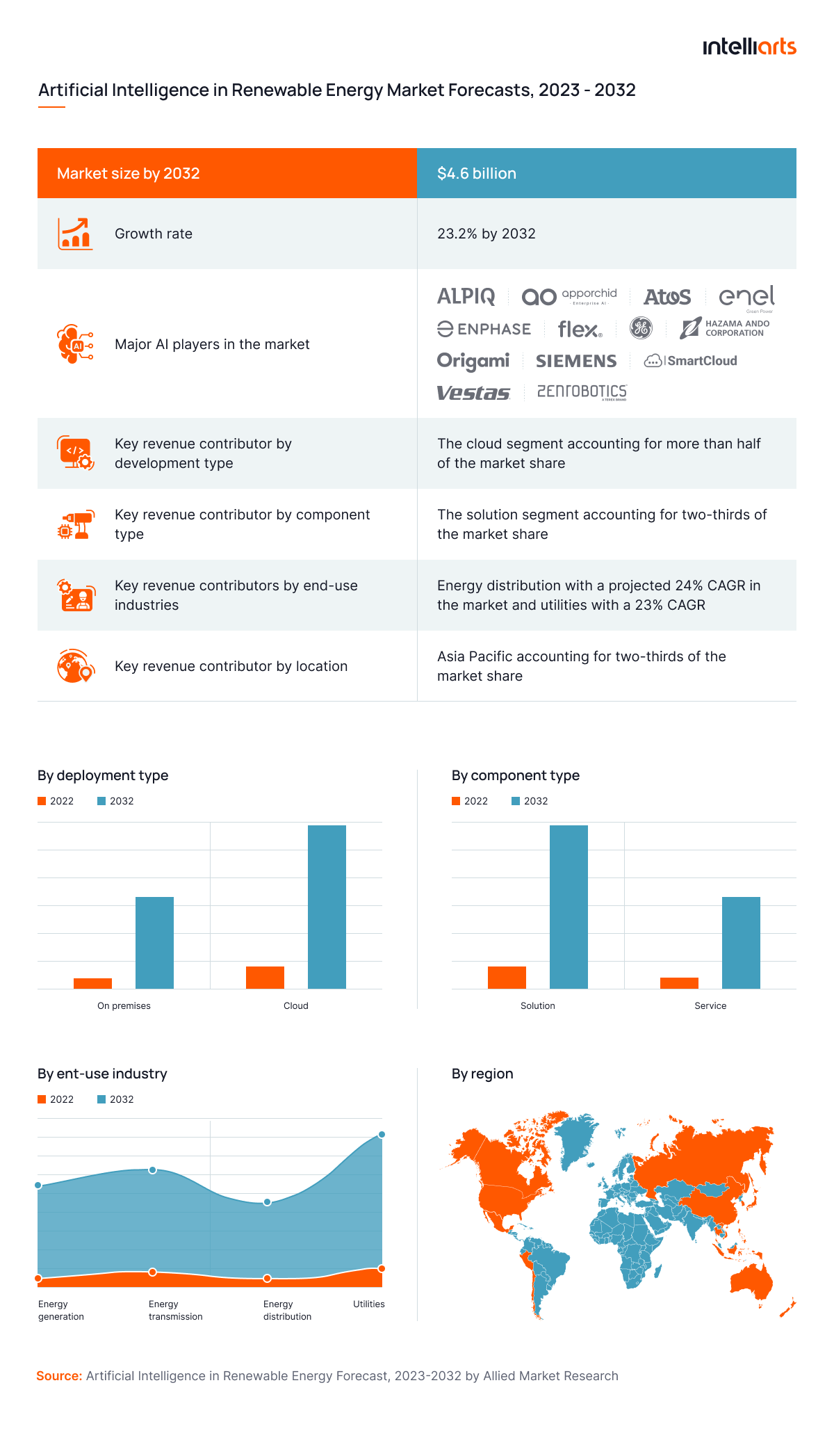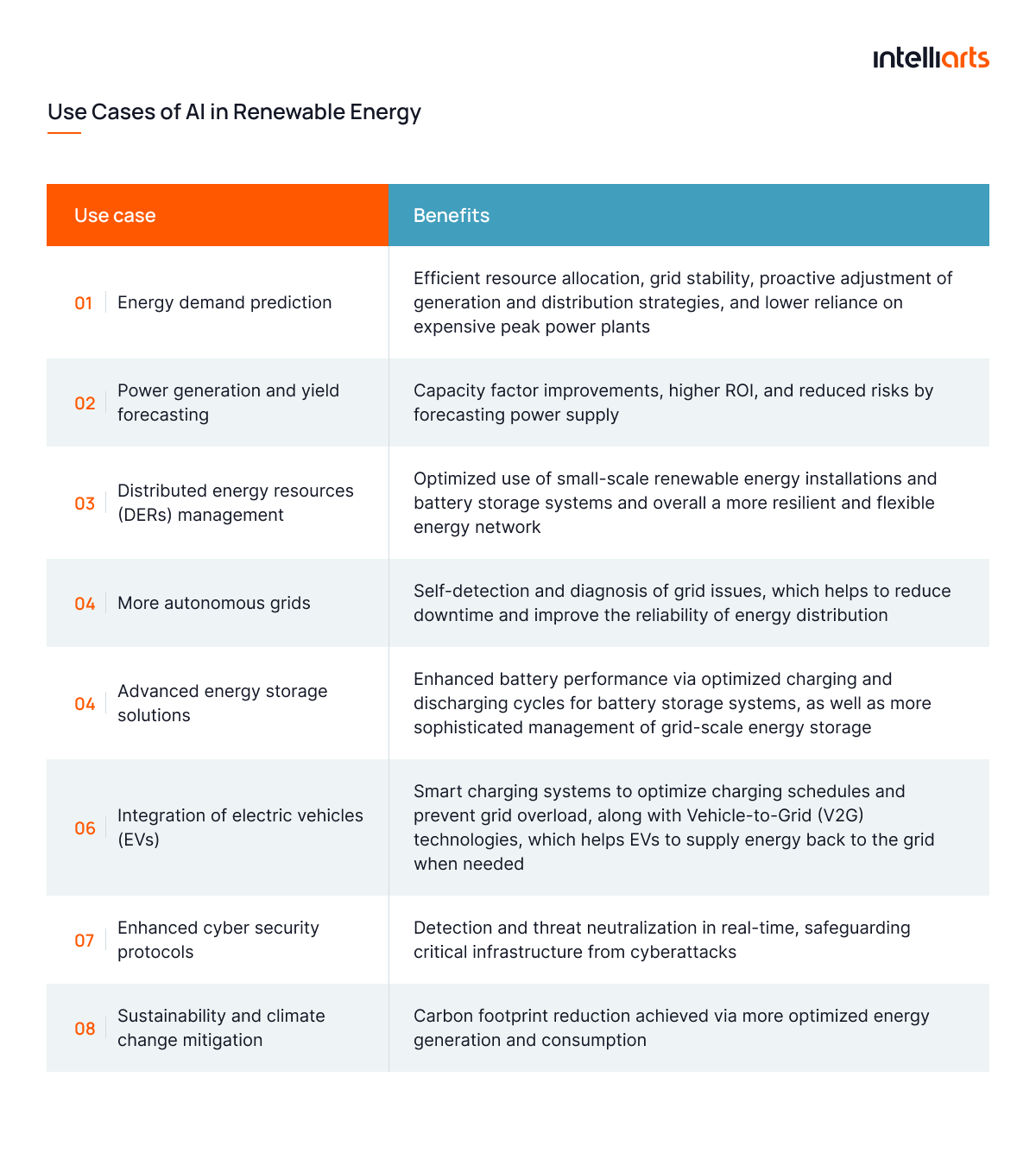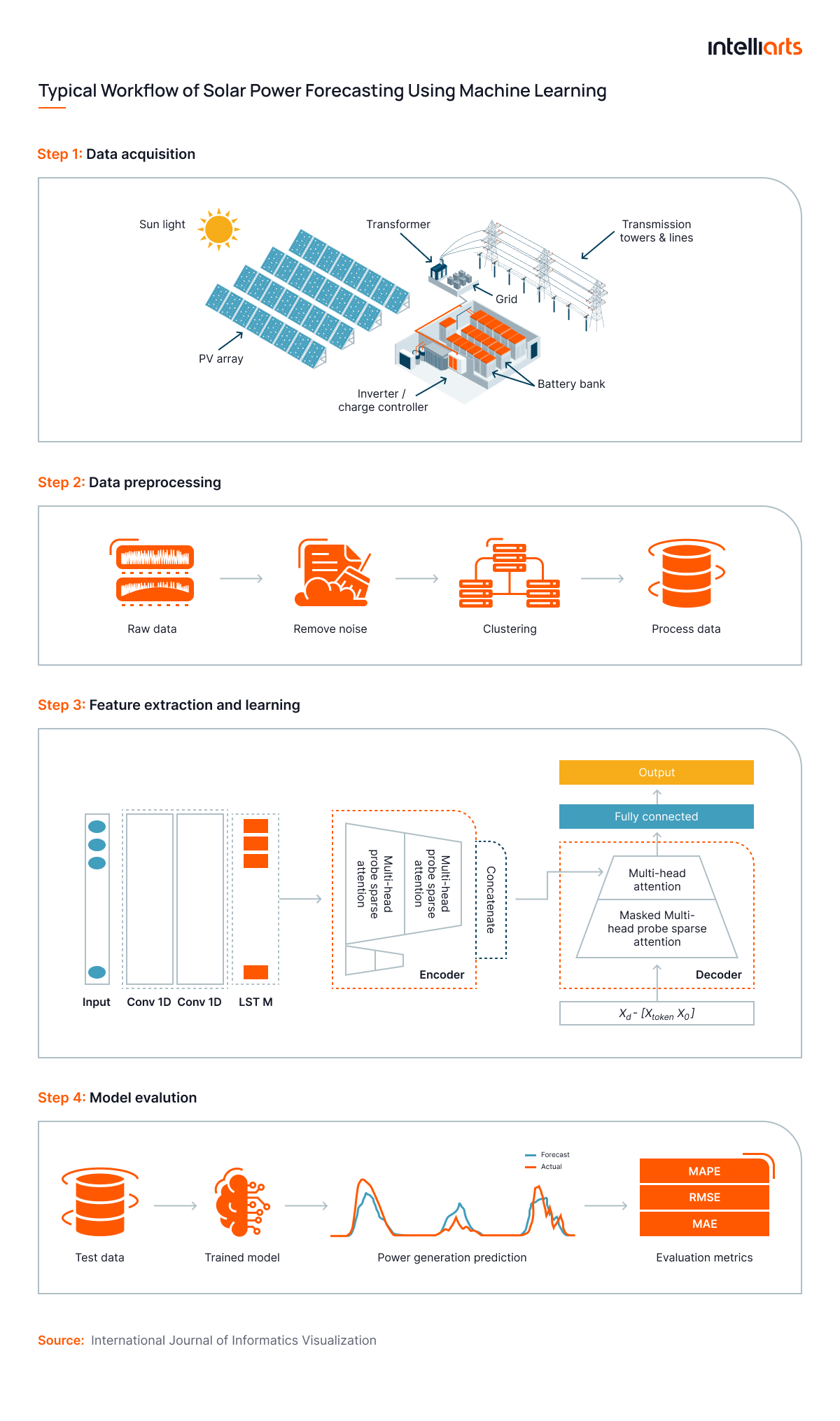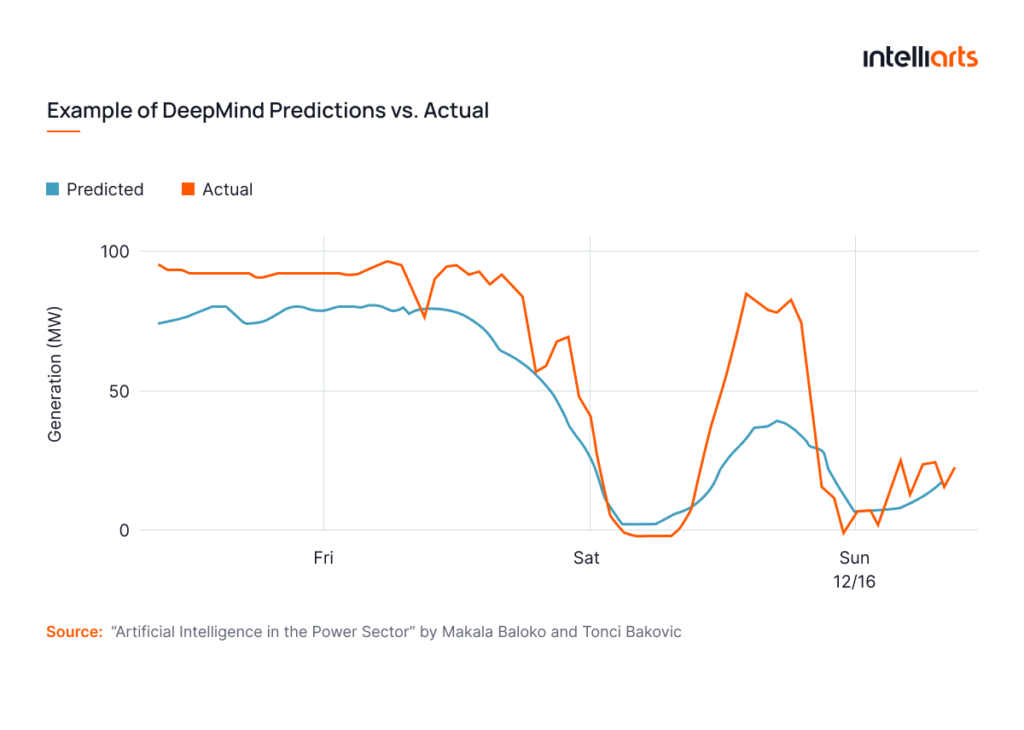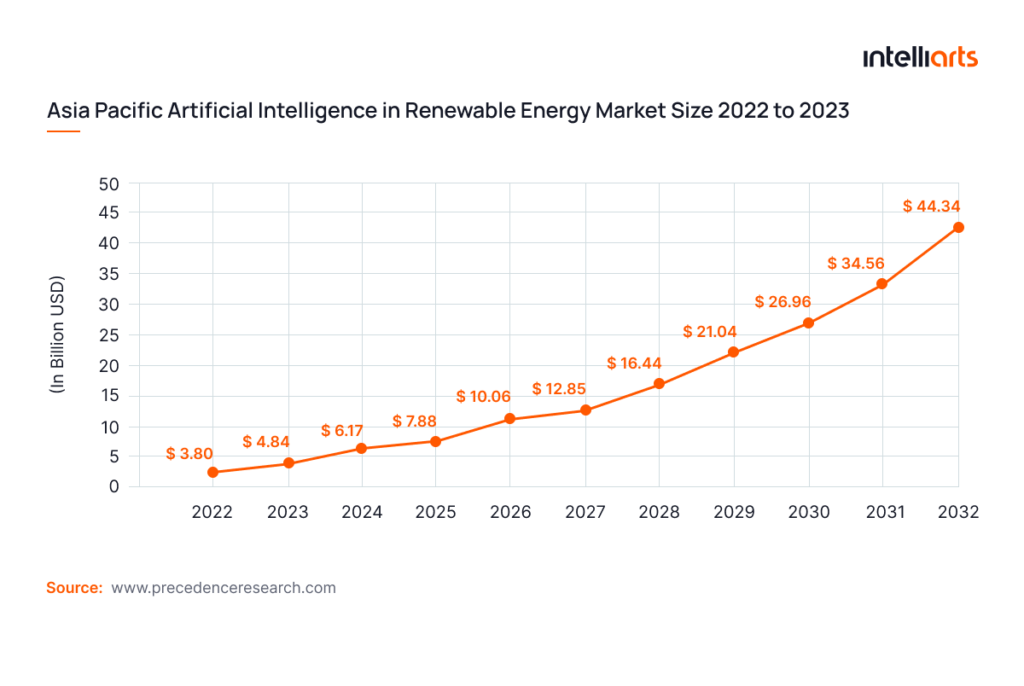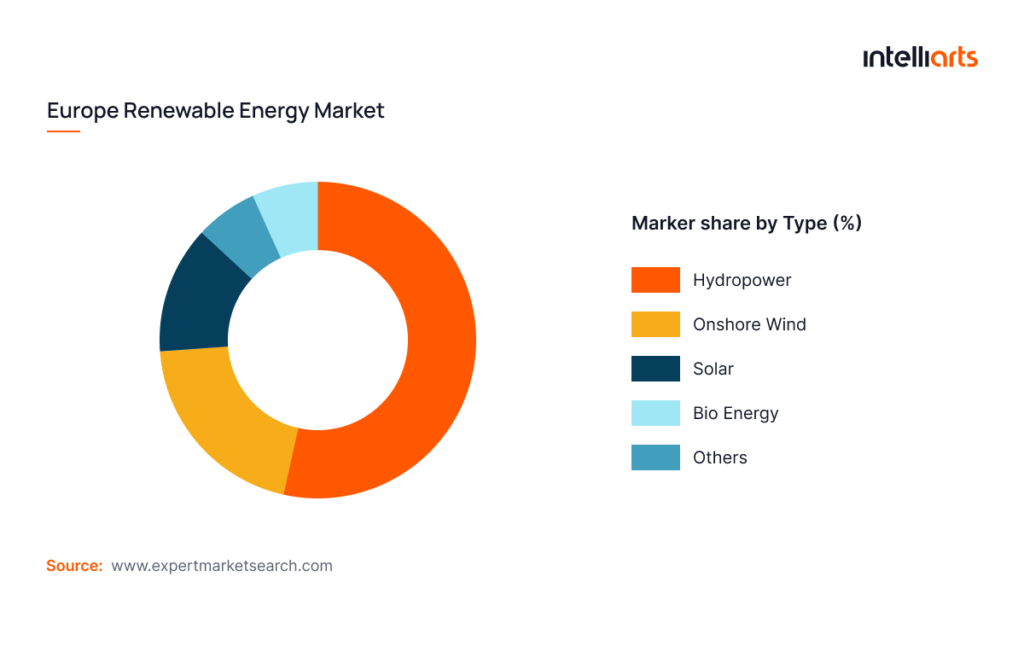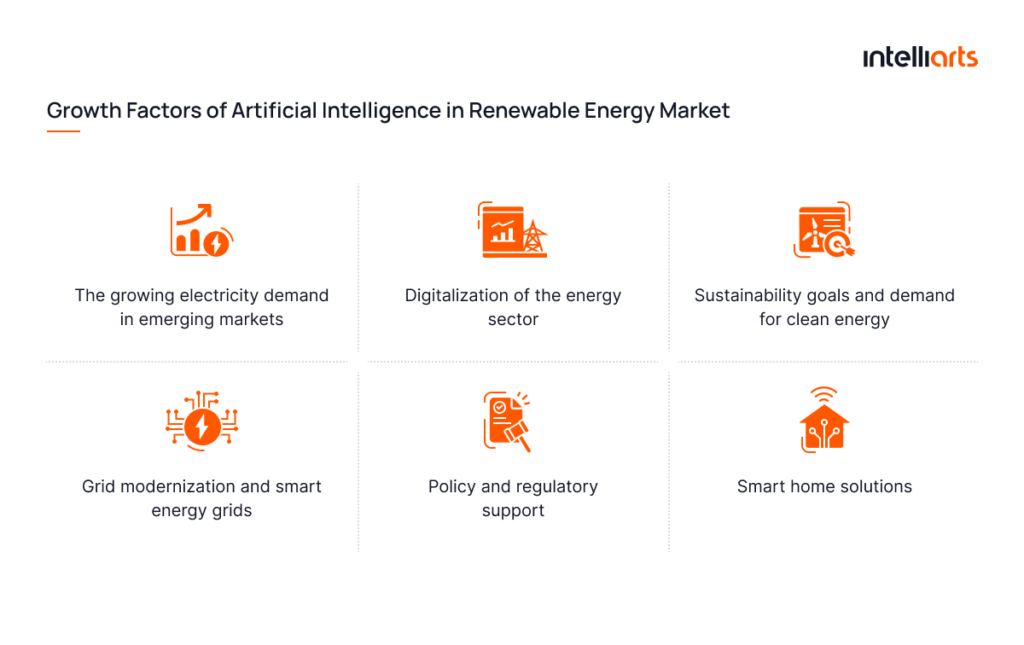Over the past few years, renewable energy has experienced a significant transformation through the integration of artificial intelligence (AI) technology. AI has revolutionized resource utilization, operational efficiency, energy management, and power system reliability in the renewable energy market. Moreover, AI’s capability to optimize energy distribution and storage systems, as well as its advanced forecasting models, enables more efficient grid management and better integration of renewable energy into existing power systems.
In this blog post, we’ll dive deep into the latest AI in renewable energy statistics and trends and explore how this technology has paved the way for a more sustainable and resilient energy future.
Artificial intelligence in renewable energy market report highlights
Allied Market Research has recently published a report on the latest statistics on AI in renewable energy, highlighting key market forecasts from 2023 to 2032. Here are the main takeaways:
- Market growth: The market size of AI in renewable energy reached $0.6 billion in 2022 and is projected to surge to $4.6 billion by 2032, with a compound annual growth rate (CAGR) of 23.2% in the period from 2023 to 2032.
- Market fragmentation: The market share of artificial intelligence in the energy market is characterized by significant fragmentation, with key players, including Alpiq, AppOrchid Inc., ATOS SE, Enel Green Power, Enphase Energy, Flex Ltd., General Electric, Hazama Ando Corporation, Origami Energy Ltd., Siemens AG, SmartCloud Inc., Vestas, and ZenRobotics Ltd.
Development type
- Cloud segment: The cloud segment was the leading revenue contributor in 2022, accounting for more than half of the market share. Its dominance is attributed to the efficient management of energy storage solutions, such as batteries, through accurate prediction of optimal charging and discharging times.
- On-premises segment: This segment is projected to have the highest CAGR of 24% from 2023 to 2032, driven by AI’s role in integrating on-premises renewable energy systems with the electrical grid, enhancing the management of excess energy and demand response programs.
Component type
- Solution segment: Leading the market with nearly two-thirds of the share and showcasing a 32.0% CAGR in 2022, the solution segment benefits from AI’s ability to facilitate peer-to-peer energy trading among consumers generating excess renewable energy.
- Service segment: Expected to grow at a CAGR of 24.0% by 2023, this segment includes applications like grid management, which adjusts energy use based on real-time supply fluctuations and price changes.
End-use industries type
- Key revenue contributors: Utilities, as well as energy distribution, segments emerged as the primary revenue contributors as compared to energy generation and energy transmission. The utilities segment is expected to reach a 23% CAGR, while energy distribution is projected to reach a 24% CAGR.
- Utilities: AI helps utilities schedule field maintenance crews efficiently, for example, by keeping in mind travel time and employee skills. This lowers costs and improves outage response times.
- Energy distribution: AI analyzes large data volumes from sensors, smart sensors, etc. to track the grid’s state in real time.
Geographical insights
- Asia Pacific: This region was the top revenue contributor in 2022, accounting for two-thirds of the global market. With the highest projected CAGR of 24%, growth is driven by substantial wind energy potential in China and India. AI and machine learning (ML) optimize wind farm operations by predicting wind patterns and adjusting turbine orientation to increase productivity.
Key artificial intelligence in energy market trends
To maximize the benefits of AI in renewable energy, businesses should stay informed about key AI in renewable energy market trends:
1. 50 use cases of AI: Recent estimates by the Indigo Advisory Group indicate that AI already has more than 50 possible applications in the energy sector in the age of renewables, from grid maintenance to load forecasting. What’s more, the market for AI technology in this sector could reach a value of up to $13 billion.
2. Predictive analytics: AI and ML algorithms analyze extensive datasets, including weather forecasts and historical energy production data, to provide precise predictions for renewable energy generation. This helps operators optimize energy production schedules and integrate renewable energy into the grid efficiently. (International Journal of Informatics Visualization)
3. Grid management: AI dynamically adjusts energy flows, monitors energy storage systems, and predicts potential grid disturbances to minimize system disruptions and ensure seamless renewable energy integration. (International Journal of Informatics Visualization)
4. Predictive maintenance: AI analyzes data from sensors to predict equipment failures before they occur. This approach can reduce grid outages by up to 30% compared to traditional methods. (E.ON)
5. Grid resilience: $188 billion extra will cost to replace power grid equipment and transformers needed from 2020 to 2050 due to its reduced lifespan because of climate change. AI can help to avoid these extra expenses by keeping transformers within optimal operational ranges. (BNEF)
6. AI-powered EV charging management: AI solutions for electric vehicle (EV) charging management can significantly reduce carbon emissions. Flexible EV charging can lower emissions by 96% by 2040. (BNEF)
7. Optimizing renewable energy systems: AI enhances the design and operation of solar farms, wind turbines, and other energy facilities. For example, ML algorithms maximize solar panel efficiency by analyzing sunshine patterns and topography and recommending optimal deployment locations and angles. (IETE Journal of Research)
8. Advanced forecasting models: AI-driven solar power forecasting models can reduce errors by 30% compared to traditional methods. (Advances in Solar Photovoltaic Energy Systems) Another example includes Google’s network model developed with DeepMind, which predicts wind power output up to 36 hours in advance, increasing its financial value by 20%. (Google)
9. Popular AI algorithms in renewable energy: Scholars identify several AI and ML algorithms used in renewable energy systems, including Support Vector Machines (SVM), Feed-forward Backpropagation Neural Network (BPNN), Adaptive Neuro-Fuzzy Inference System (ANFIS), Naïve Bayes (NB), Genetic Algorithm (GA), Artificial Neural Network (ANN), Radial basis function neural networks (RBFNN), and others. Among these, ANN is recognized as the best modeling technique, with accuracy reaching 94-99%. (IEEE)
Stay tuned for more insights as we delve deeper into how AI continues to transform the renewable energy landscape.
AI in renewable energy market share by region
To gain more meaningful insights, let’s review the analysis of AI in renewable energy market share by region and compare the numbers:
Asia Pacific
The Asia Pacific region leads in AI in renewable energy market growth. According to Precedence Research, the market share is projected to grow from $4.8 billion in 2023 to $44 billion by 2032, with a CAGR of 28%. This is even more promising compared to the earlier results from Allied Market Research.
Key drivers for this growth include significant electricity shortages and rising demand in countries like India. For instance, India’s electricity generation from solar and wind energy, currently at 75 watts, is expected to increase to 175 watts by 2022 and potentially reach 500 watts by 2030 with the help of AI. Additionally, the presence of key market players specializing in AI in this region fuels growth.
North America
North America had the highest AI in renewable energy market share up until 2022, driven by technological advancements. Now it’s expected to show the second-fastest growth rate, as per the Precedent Research artificial intelligence in renewable energy market forecast. This growth is attributed to the continued adoption of AI technologies and solutions, as well as the digital transformation of the energy sector. For example, AI adoption for smart home solutions is particularly popular in North America.
Europe
Europe also plays a significant role due to its strong focus on renewable energy and technological innovation, as per the Allied Market Research. The European Union recognizes AI’s potential to positively impact the renewable energy sector, especially in terms of load forecasts, demand predictions, and improved grid flexibility.
That’s why we observe a strong emphasis on sustainable and responsible AI solutions, as well as substantial governmental support and regulatory frameworks. Countries like Germany, France, the UK, and Italy lead in deploying AI technologies in renewable energy. Initiatives such as I-NERGY, which plans to implement 15 pilot AI use cases in renewable energy, are gaining traction and funding.
However, the high cost of implementing AI technologies remains a significant barrier, necessitating investment in research, expertise, and high-performance computing infrastructure.
Latin America
The prognosis for Latin America is less promising. Despite the Latin American Energy Organization (OLADE) setting a renewable energy goal of 70% by 2030, AI in renewable energy market size remains small due to a shortage of skilled professionals and high technology costs. The rapid advancements in AI also complicate understanding its full impact and potential, leading to incomplete strategies by businesses.
Middle East
In the Middle East, renewable energy, particularly solar and wind, is growing substantially. Solar power capacity increased from 1 GW in 2015 to 8.4 GW in 2021. The UAE is a key player, with projects like the Mohammed bin Rashid Solar Park aiming for 50% clean energy by 2050. AI optimizes energy management, enhances grid stability, and improves efficiency in these projects. However, GlobalData Plc forecasts that thermal power plants will still constitute 70% of total capacity by 2035. Political instability, infrastructure gaps, lack of finances, and low social acceptance are major obstacles.
Africa
As everywhere else in the world, the renewable energy market in Africa is growing, focusing on sources such as hydropower, wind, solar, bioenergy, and geothermal. AI improves forecasting, maintenance, and overall management of renewable energy systems. Countries like South Africa, Egypt, Ethiopia, and Kenya lead in renewable energy installations and innovations. However, Africa lags behind other regions in adopting AI in renewable energy due to a lack of open data ecosystems, quality data to support AI models, low connectivity, and limited digital skills.
AI in energy market growth factors
The growing share of AI in the renewable energy market is driven by several factors:
- Increasing electricity demand: Both emerging and established regions see a rising electricity demand, together with the growing need for smart energy grids and the overall digitalization of the energy sector. (Precedence Research)
- Efficiency and optimization: AI identifies bottlenecks in the energy sector, optimizing processes and contributing to market growth. It enhances the efficiency of systems like wind turbines and solar panels, making them more cost-effective and accelerating their adoption. (Precedence Research)
- Sustainability and environmental concerns: The global shift towards sustainability and concerns about carbon and greenhouse gas emissions drive the development of clean energy technologies. AI improves these systems’ efficiency, further promoting their adoption. (Precedence Research)
- Government initiatives: Governments worldwide support AI in renewable energy through policies and funding. For example, Great Britain recently backed eight AI projects in renewable energy with £1.7 million ($2.1 million).
- Smart grids as a national policy: The US Department of Energy chose smart grids as a national policy goal, with AI serving as the system’s brain. Model-based predictive control can improve energy efficiency by 10.2% to 40%. (SAP Smart Grid Report)
- COVID-19: The COVID-19 pandemic also added to the growth of the global AI renewable energy market. Energy manufacturing units were halted during the outbreak, hindering the market’s development in 2020. (Precedence Research)
- Smart home solutions: AI-driven smart home energy management systems reduce household energy usage by up to 10%, providing real-time data and insights for informed decision-making and energy-saving actions. (WEF)
Final thoughts
AI is not just enhancing renewable energy systems — it’s transforming them into highly efficient, dynamic entities. From demand predictions to power generation and yield forecasting to smart grids, AI optimizes every stage of energy generation, consumption, and distribution, ensuring maximum efficiency. Respectively, the artificial intelligence in renewable energy market size continues to grow as AI advances, highlighting its critical role in this sector. This synergy between AI and renewable energy represents a pivotal step toward a sustainable and environmentally conscious future.
Want to take a step forward to bring your renewable energy project to maximum efficiency? With our domain knowledge of AI in the renewable energy market, Intelliarts can partner with you to enhance your energy solutions through automation and valuable data insights. Our company builds renewable energy software and end-to-end AI-driven solutions and can help you with:
- Predictive maintenance for your renewable energy assets
- Energy demand forecasting
- Smart grid solutions
- Power management systems
- EV charging management solutions
- EV fleet management
FAQ
Several factors contribute to the growing integration of AI in renewable energy: the rising electricity demand and grid modernization, digitalization of the energy sector, the course for sustainability, and policy and regulatory support.
The Asia Pacific region is expected to lead the global AI in the energy market. The increasing demand for electricity, especially in India, contributes to the adoption of AI in this region.
Among the key players, we can mention Alpiq, ATOS SE, Enel Green Power, Enphase Energy, General Electric, Siemens AG, etc. Importantly, lots of these are from the Asia Pacific region and North America, which explains their largest market shares in this domain.


